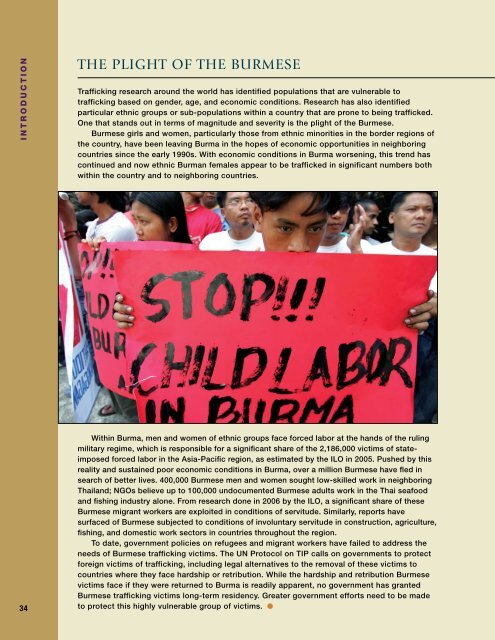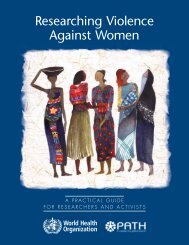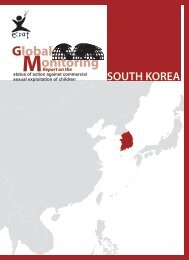2007 Trafficking in Persons Report - Center for Women Policy Studies
2007 Trafficking in Persons Report - Center for Women Policy Studies
2007 Trafficking in Persons Report - Center for Women Policy Studies
You also want an ePaper? Increase the reach of your titles
YUMPU automatically turns print PDFs into web optimized ePapers that Google loves.
I N T R O D U C T I O N<br />
The Plight of the Burmese<br />
<strong>Traffick<strong>in</strong>g</strong> research around the world has identified populations that are vulnerable to<br />
traffick<strong>in</strong>g based on gender, age, and economic conditions. Research has also identified<br />
particular ethnic groups or sub-populations with<strong>in</strong> a country that are prone to be<strong>in</strong>g trafficked.<br />
One that stands out <strong>in</strong> terms of magnitude and severity is the plight of the Burmese.<br />
Burmese girls and women, particularly those from ethnic m<strong>in</strong>orities <strong>in</strong> the border regions of<br />
the country, have been leav<strong>in</strong>g Burma <strong>in</strong> the hopes of economic opportunities <strong>in</strong> neighbor<strong>in</strong>g<br />
countries s<strong>in</strong>ce the early 1990s. With economic conditions <strong>in</strong> Burma worsen<strong>in</strong>g, this trend has<br />
cont<strong>in</strong>ued and now ethnic Burman females appear to be trafficked <strong>in</strong> significant numbers both<br />
with<strong>in</strong> the country and to neighbor<strong>in</strong>g countries.<br />
34<br />
With<strong>in</strong> Burma, men and women of ethnic groups face <strong>for</strong>ced labor at the hands of the rul<strong>in</strong>g<br />
military regime, which is responsible <strong>for</strong> a significant share of the 2,186,000 victims of stateimposed<br />
<strong>for</strong>ced labor <strong>in</strong> the Asia-Pacific region, as estimated by the ILO <strong>in</strong> 2005. Pushed by this<br />
reality and susta<strong>in</strong>ed poor economic conditions <strong>in</strong> Burma, over a million Burmese have fled <strong>in</strong><br />
search of better lives. 400,000 Burmese men and women sought low-skilled work <strong>in</strong> neighbor<strong>in</strong>g<br />
Thailand; NGOs believe up to 100,000 undocumented Burmese adults work <strong>in</strong> the Thai seafood<br />
and fish<strong>in</strong>g <strong>in</strong>dustry alone. From research done <strong>in</strong> 2006 by the ILO, a significant share of these<br />
Burmese migrant workers are exploited <strong>in</strong> conditions of servitude. Similarly, reports have<br />
surfaced of Burmese subjected to conditions of <strong>in</strong>voluntary servitude <strong>in</strong> construction, agriculture,<br />
fish<strong>in</strong>g, and domestic work sectors <strong>in</strong> countries throughout the region.<br />
To date, government policies on refugees and migrant workers have failed to address the<br />
needs of Burmese traffick<strong>in</strong>g victims. The UN Protocol on TIP calls on governments to protect<br />
<strong>for</strong>eign victims of traffick<strong>in</strong>g, <strong>in</strong>clud<strong>in</strong>g legal alternatives to the removal of these victims to<br />
countries where they face hardship or retribution. While the hardship and retribution Burmese<br />
victims face if they were returned to Burma is readily apparent, no government has granted<br />
Burmese traffick<strong>in</strong>g victims long-term residency. Greater government ef<strong>for</strong>ts need to be made<br />
to protect this highly vulnerable group of victims. l
















